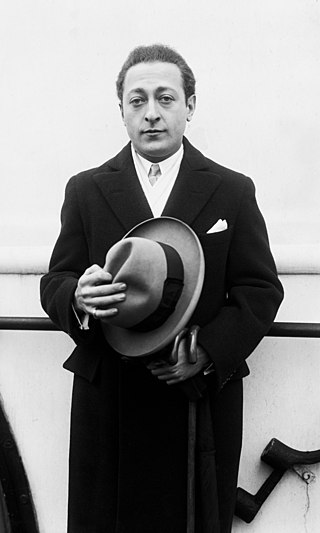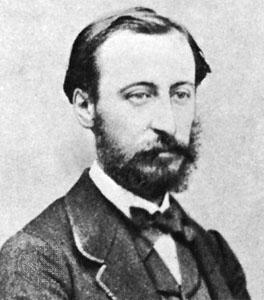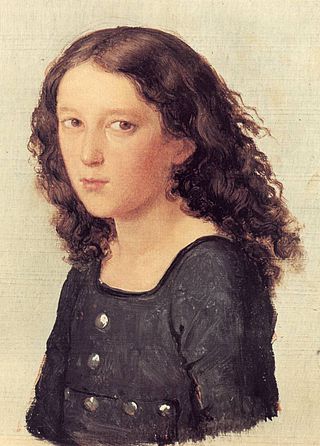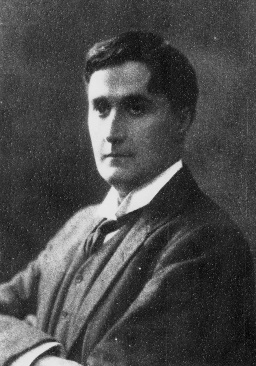Related Research Articles

In music, a cadenza is, generically, an improvised or written-out ornamental passage played or sung by a soloist or soloists, usually in a "free" rhythmic style, and often allowing virtuosic display. During this time the accompaniment will rest, or sustain a note or chord. Thus an improvised cadenza is indicated in written notation by a fermata in all parts. A cadenza will usually occur over the final or penultimate note in a piece, the lead-in, or over the final or penultimate note in an important subsection of a piece. It can also be found before a final coda or ritornello.

Ralph Vaughan Williams, was an English composer. His works include operas, ballets, chamber music, secular and religious vocal pieces and orchestral compositions including nine symphonies, written over sixty years. Strongly influenced by Tudor music and English folk-song, his output marked a decisive break in British music from its German-dominated style of the 19th century.

A piano concerto, a type of concerto, is a solo composition in the classical music genre which is composed for piano accompanied by an orchestra or other large ensemble. Piano concertos are typically virtuosic showpieces which require an advanced level of technique. Piano Concertos are typically written out in music notation, including sheet music for the pianist, orchestral parts, and a full score for the conductor.

Sergei Rachmaninoff's Piano Concerto No. 3 in D minor, Op. 30, was composed in the summer of 1909. The piece was premiered on November 28 of that year in New York City with the composer as soloist, accompanied by the New York Symphony Society under Walter Damrosch. The work has the reputation of being one of the most technically challenging piano concertos in the standard classical piano repertoire.
The Cello Concerto in A minor, Op. 129, by Robert Schumann was completed in a period of only two weeks, between 10 October and 24 October 1850, shortly after Schumann became the music director at Düsseldorf.
Symphony No. 5 in D major by the English composer Ralph Vaughan Williams was written between 1938 and 1943. In style it represents a shift away from the violent dissonance of his Fourth Symphony, and a return to the gentler style of the earlier Pastoral Symphony.

The Violin Concerto by William Walton was written in 1938–39 and dedicated to Jascha Heifetz, who commissioned the work and performed it at its premiere on 7 December 1939 with the Cleveland Orchestra conducted by Artur Rodziński. The British premiere, delayed by the Second World War, was given on 1 November 1941, with Henry Holst as soloist and the composer conducting. Walton later reorchestrated the concerto; the revised version was premiered in 1944. The work has been frequently recorded and has established itself as one of the composer's most durable compositions.

Ludwig van Beethoven's Piano Concerto No. 4 in G major, Op. 58, was composed in 1805–1806. Beethoven was the soloist in the public premiere as part of the concert on 22 December 1808 at Vienna's Theater an der Wien.

The Piano Concerto No. 4 in C minor, Op. 44 was composed by Camille Saint-Saëns in 1875. It was premièred on October 31, 1875, at the Théâtre du Châtelet of Paris, with the composer as the soloist. The concerto is dedicated to Anton Door, a professor of piano at the Vienna Conservatory. It continues to be one of Saint-Saëns' most popular piano concertos, second only to the Piano Concerto No. 2 in G minor.
The Piano Concerto No. 3 in E major, Sz. 119, BB 127 of Béla Bartók is a musical composition for piano and orchestra. The work was composed in 1945 during the final months of his life, as a surprise birthday present for his second wife Ditta Pásztory-Bartók.

Pyotr Ilyich Tchaikovsky's Piano Concerto No. 3 in E-flat major was at first conceived by him as a symphony in the same key. But he abandoned that idea, jetisoned all but the planned first movement, and reworked this in 1893 as a one-movement Allegro brillante for piano and orchestra. His last completed work, it was duly published as Opus 75 the next year, after he died, but given by publisher Jurgenson the title "Concerto No. 3 pour Piano avec accompagnement d'Orchestre".
The Concert Fantasia in G, Op. 56, for piano and orchestra, was written by Pyotr Ilyich Tchaikovsky between June and October 1884. It was premiered in Moscow on 6 March [O.S. 22 February] 1885, with Sergei Taneyev as soloist and Max Erdmannsdörfer conducting. The Concert Fantasia received many performances in the first 20 years of its existence. It then disappeared from the repertoire and lay virtually unperformed for many years, but underwent a revival in the latter part of the 20th century.

The Symphony No. 2 in F minor was written by Richard Strauss between 1883 and 1884. It is sometimes referred to as just Symphony in F minor. He gave it the Opus number 12, and it also appears in other catalogues as TrV 126 and Hanstein A.I.2. It is not listed in von Asow's catalog.
The Piano Concerto in B-flat, Op. 58, F.108, was written by Arthur Bliss in 1938 and premiered in 1939. It is a powerful work in the nineteenth-century Romantic tradition, and at the time it was hoped it could prove to be a British "Emperor" concerto. Nicolas Slonimsky described it as "Lisztomorphic in its sonorous virtuosity, Chopinoid in its chromatic lyricism, and Rachmaninovistic in its chordal expansiveness".
The Piano Concerto is a concerto for solo piano and orchestra by the American composer Jennifer Higdon. It was commissioned by the National Symphony Orchestra and was first performed December 3, 2009 at the John F. Kennedy Center for the Performing Arts in Washington, D.C. The premiere featured pianist Yuja Wang and the National Symphony Orchestra under conductor Andrew Litton.

The Concerto for Piano, Violin, and Strings in D minor, MWV O4, also known as the Double Concerto in D minor, was written in 1823 by Felix Mendelssohn when he was 14 years old. This piece is Mendelssohn's fourth work for a solo instrument with orchestral accompaniment, preceded by a Largo and Allegro in D minor for Piano and Strings MWV O1, the Piano Concerto in A Minor MWV O2, and the Violin Concerto in D minor MWV O3. Mendelssohn composed the work to be performed for a private concert on May 25, 1823 at the Mendelssohn home in Berlin with his violin teacher and friend, Eduard Rietz. Following this private performance, Mendelssohn revised the scoring, adding winds and timpani and is possibly the first work in which Mendelssohn used winds and timpani in a large work. A public performance was given on July 3, 1823 at the Berlin Schauspielhaus. Like the A minor piano concerto (1822), it remained unpublished during Mendelssohn's lifetime and it wasn't until 1999 when a critical edition of the piece was available.
The Concerto for Piano and Orchestra is a composition for solo piano and orchestra by the Polish composer Witold Lutosławski. The music was commissioned by the Salzburg Festival. It was first performed at the festival on August 19, 1988 by the pianist Krystian Zimerman and the Austrian Radio Orchestra under the direction of the composer. Lutosławski dedicated the piece to Zimerman.
The Piano Concerto No. 2, Op. 39, is the second piano concerto by the Argentinian composer Alberto Ginastera. The work was commissioned by the Indianapolis Symphony Orchestra for the pianist Hilde Somer, to whom the concerto is dedicated. It was first performed by Somer and the Indianapolis Symphony Orchestra conducted by Izler Solomon on March 22, 1973.

The Lark Ascending is a short, single-movement work by the English composer Ralph Vaughan Williams, inspired by the 1881 poem of the same name by the English writer George Meredith. It was originally for violin and piano, completed in 1914, but not performed until 1920. The composer reworked it for solo violin and orchestra after the First World War. This version, in which the work is chiefly known, was first performed in 1921. It is subtitled "A Romance", a term that Vaughan Williams favoured for contemplative slow music.
The Piano Concerto No. 3 is a composition for solo piano and orchestra by the Finnish composer Magnus Lindberg. The work was jointly commissioned by China National Centre for The Performing Arts, San Francisco Symphony, Toronto Symphony Orchestra, Philharmonie de Paris - Orchestre de Paris, NDR Elbphilharmonie Orchester, and the New York Philharmonic.